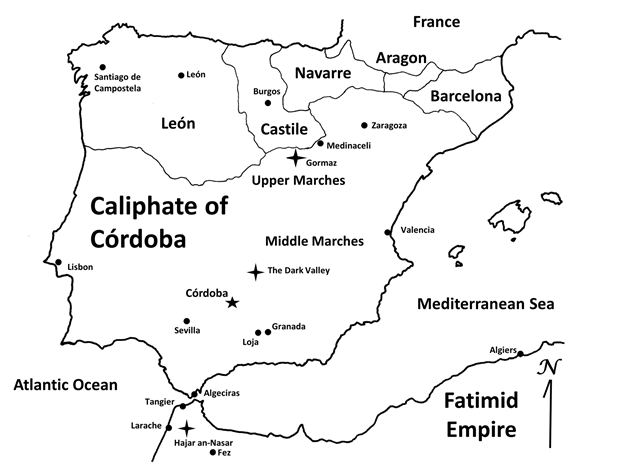In the Islamic world, the death of the Prophet Muhammad in 632 C.E. without a chosen successor led to several decades of bloody internal power struggle, the remnants of which linger to this day in Shiite vs. Sunni tensions. By 661, however, the Sunni Arab Umayyad clan prevailed, and to solidify their power moved the Islamic capital from Medina (Saudi Arabia) to Damascus (Syria). A rapid swelling of Islamic culture, wealth and power ensued, launching a conquest of conversion reaching from the western end of the Mediterranean basin to the Near East.
By 711, the Maghreb was breached (land including the rugged Atlas mountains of extreme northwest Africa and the coastal plains of modern Morocco, Algeria, Tunisia, and Libya). An Islamic army, led by an Arab Syrian general named Tariq ibn Ziyad and comprised of a freshly-converted, capable warrior clan of local Berber tribesmen, invaded Iberia at Gibraltar. They rapidly conquered the Iberian peninsula under the banner of jihad, effortlessly absorbing the nominally-Christian Visigoths and post-Roman era towns and peoples. The incursion of the Muslims was largely welcomed, and in some cases were even assisted by, the Iberian Jews, who had long been persecuted by the local Christians. Al-Andalus, the Arabic name for the lands of Iberia under Muslim rule, was born in 711. Al-Andalus will endure for 791 years.
Several pivotal events in the history of al-Andalus are important to Shadows in the Shining City. In 750 C.E., the Umayyads in Damascus were slaughtered by the rival Abbasids, and the sole surviving Umayyad heir, Abd al-Rahman, a boy in his late teens, set out on the twenty-five hundred mile journey to al-Andalus to boldly reclaim his own slice of history in a forgotten corner of the Islamic empire, Córdoba, located on the banks of the Guadalquivir river in southern central Spain. The Umayyad regime re-emerged like a phoenix from the ashes with the crowning of Abd al-Rahman Emir of Córdoba in 756. He set about unifying al-Andalus, and one of his first mandates, remarkably enough, was to welcome both Jews and Christians into his kingdom.
Al-Andalus blossomed under Umayyad rule. Abd al-Rahman’s grandson (the III) declared himself the rival Caliph (from the Arabic khalifa, “successor” (to the Prophet Muhammad) – supreme ruler of Islam) to the Abbasid Caliph in January 929. Unified and under capable and enlightened Syrian-Arab leadership, al-Andalus rose to its full glory.
Córdoba becomes the crown jewel of Western Islam and a magnet of learning and intellectual fervor that rivaled Baghdad. Late tenth century Córdoba was the largest city in Europe, with a population of over 300,000. The city was rich beyond belief, with a revenue estimated to be 40,000,000 gold dinars per annum. Public works abounded. The citizens enjoyed baths, sewers, hospitals, running water, indoor toilets, and lighted streets. Córdoba had the largest library in the Europe, with over 400,000 volumes in the Royal Library alone. Convivencia reigned.
In 936, Caliph Abd al-Rahman III, following Islamic tradition, broke ground on Madinat al-Zahra, the Shining City, a massive Royal Palace complex located several miles to the west of Córdoba at the edge of the Sierra Morena mountains. His intent? To create the most lavish Islamic palace in the world, an edifice fitting for a Caliph.
Legend has it that 10,000 workers labored four years to complete the first phase of construction. The massive, 112 hectare, walled complex of Madinat al-Zahra was built on three enormous terraces cut from the side of the mountain. It contained ceremonial reception halls, mosques, administrative and government offices, the Royal Treasury, libraries, Islamic gardens, the Royal Mint, a zoo of exotic animals, artisan’s workshops of all manner, a garrison for several thousand troops, parade grounds, orchards, lavish residences for the Royal Court, and of course heated baths by the dozen. Madinat was a city of flowing water and elaborate fountains, supplied to the entire complex through aqueducts from the mountain streams of the Sierra Morena. No expense was spared to create the most ostentatious palace in the world.
Our story begins in Madinat al-Zahra on 8 April 975. This period, the late tenth century, is considered the economic, cultural and intellectual zenith of the 791 year history of al-Andalus.
